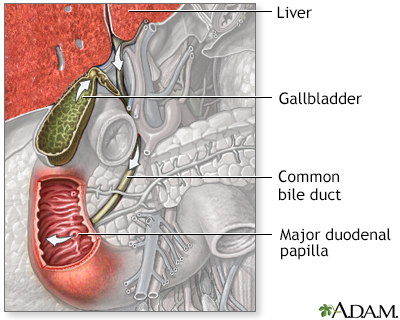Bile duct stricture
Bile duct stricture; Biliary stricture
A bile duct stricture is an abnormal narrowing, most often of the common bile duct. This is a tube that moves bile from the liver to the small intestine. Bile is a substance that helps with digestion.
Images

I Would Like to Learn About:
Causes
A bile duct stricture is often caused by injury to the bile ducts during surgery. For example, it may occur after surgery to remove the gallbladder.
Other causes of this condition include:
- Cancer of the bile duct, liver or pancreas
- Damage and scarring due to a gallstone in the bile duct
- Damage or scarring after gallbladder removal
- Pancreatitis
- Primary sclerosing cholangitis
Symptoms
Symptoms include:
- Abdominal pain on the upper right side of belly
- Chills
- Fever
- Itching
- General feeling of discomfort
- Loss of appetite
- Jaundice
- Nausea and vomiting
- Pale or clay-colored stools
Exams and Tests
The following tests can help diagnose this condition:
- Endoscopic retrograde cholangiopancreatography (ERCP)
- Percutaneous transhepatic cholangiogram (PTC)
- Magnetic resonance cholangiopancreatography (MRCP)
- Endoscopic ultrasound (EUS)
The following blood tests can help reveal a problem with the biliary system.
- Alkaline phosphatase (ALP) is higher than normal.
- GGT enzyme level is higher than normal.
- Bilirubin level is higher than normal.
This condition may also alter the results of the following tests:
- Amylase level
- Lipase level
- Urine bilirubin
- Prothrombin time (PT)
Treatment
The goal of treatment is to correct the narrowing. This will allow bile to flow from the liver into the intestine.
This may involve:
- Surgery
- Endoscopic or percutaneous dilation of the stricture or insertion of stents through the stricture
If surgery is done, the stricture is removed. The common bile duct will be rejoined with the small intestine.
In some cases, a tiny metal or plastic mesh tube (stent) is placed across the bile duct stricture to keep it open.
Outlook (Prognosis)
Treatment is successful most of the time. Long-term success depends on the cause of the stricture.
Possible Complications
Inflammation and narrowing of the biliary duct may return in some people. There is a risk for infection above the narrowed area. Strictures that remain for a long period can lead to liver damage (cirrhosis).
When to Contact a Medical Professional
Contact your health care provider if symptoms recur after pancreatitis, cholecystectomy, or other biliary surgery.
Related Information
BileCholedocholithiasis
Sclerosing cholangitis
Open gallbladder removal
Gallstones
Cirrhosis
References
Dudeja V, Ferrantella A, Fong Y. The liver. In: Townsend CM Jr, Beauchamp RD, Evers BM, Mattox KL, eds. Sabiston Textbook of Surgery. 21st ed. St Louis, MO: Elsevier; 2022:chap 54.
Fogel EL, Sherman S. Diseases of the gallbladder and bile ducts. In: Goldman L, Cooney KA, eds. Goldman-Cecil Medicine. 27th ed. Philadelphia, PA: Elsevier; 2024:chap 141.
Lillemoe HA, Lillemoe KD. Gallbladder and biliary tree: management of benign biliary strictures. In: Cameron J, ed. Current Surgical Therapy. 14th ed. Philadelphia, PA: Elsevier; 2023:457-538.
BACK TO TOPReview Date: 5/14/2024
Reviewed By: Jenifer K. Lehrer, MD, Department of Gastroenterology, Aria - Jefferson Health Torresdale, Jefferson Digestive Diseases Network, Philadelphia, PA. Review provided by VeriMed Healthcare Network. Also reviewed by David C. Dugdale, MD, Medical Director, Brenda Conaway, Editorial Director, and the A.D.A.M. Editorial team.

Health Content Provider
06/01/2025
|
A.D.A.M., Inc. is accredited by URAC, for Health Content Provider (www.urac.org). URAC's accreditation program is an independent audit to verify that A.D.A.M. follows rigorous standards of quality and accountability. A.D.A.M. is among the first to achieve this important distinction for online health information and services. Learn more about A.D.A.M.'s editorial policy, editorial process and privacy policy. A.D.A.M. is also a founding member of Hi-Ethics. This site complied with the HONcode standard for trustworthy health information from 1995 to 2022, after which HON (Health On the Net, a not-for-profit organization that promoted transparent and reliable health information online) was discontinued. |
The information provided herein should not be used during any medical emergency or for the diagnosis or treatment of any medical condition. A licensed medical professional should be consulted for diagnosis and treatment of any and all medical conditions. Links to other sites are provided for information only -- they do not constitute endorsements of those other sites. © 1997- 2025 A.D.A.M., a business unit of Ebix, Inc. Any duplication or distribution of the information contained herein is strictly prohibited.
